Anupam Pareek
Lead Product & Game Design @ Rush Gaming Universe By Hike
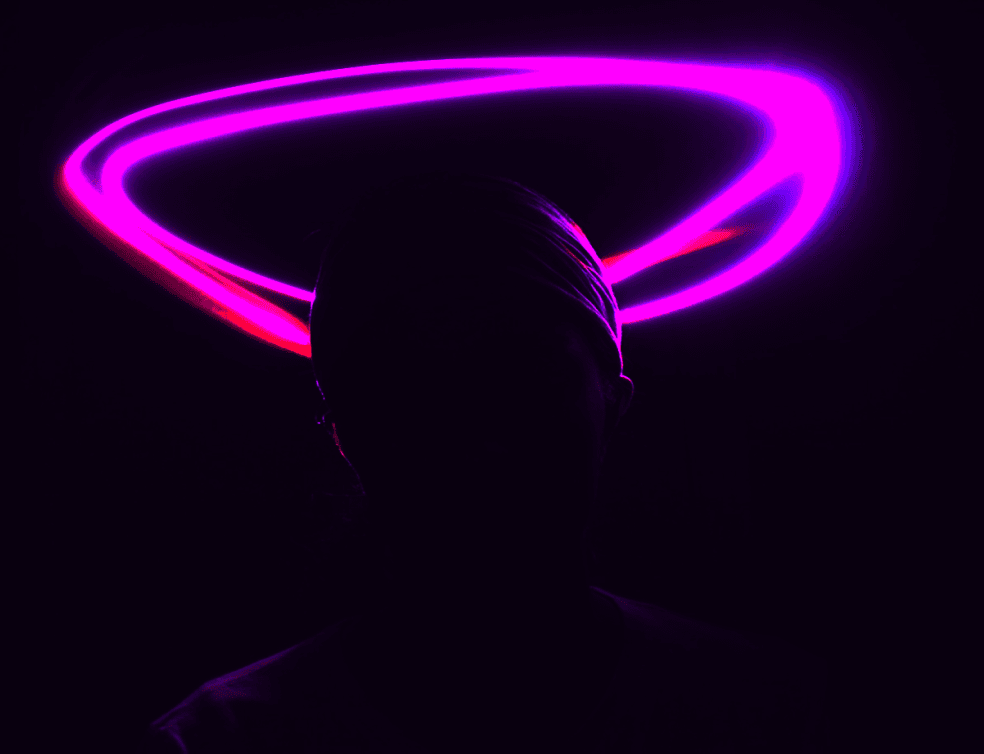

Anupam Pareek
Lead Product & Game Design @ Rush Gaming Universe By Hike


Anupam Pareek
Lead Product & Game Design @ Rush Gaming Universe By Hike


Anupam Pareek
Lead Product & Game Design @ Rush Gaming Universe By Hike




Creating a successful game is an art that requires a keen understanding of player behaviour, design principles, and a careful balance between simplicity and engagement...FULL STORY ↗️
Case Study
Creating a successful game is an art that requires a keen understanding of player behaviour, design principles, and a careful balance between simplicity and engagement...FULL STORY↗️
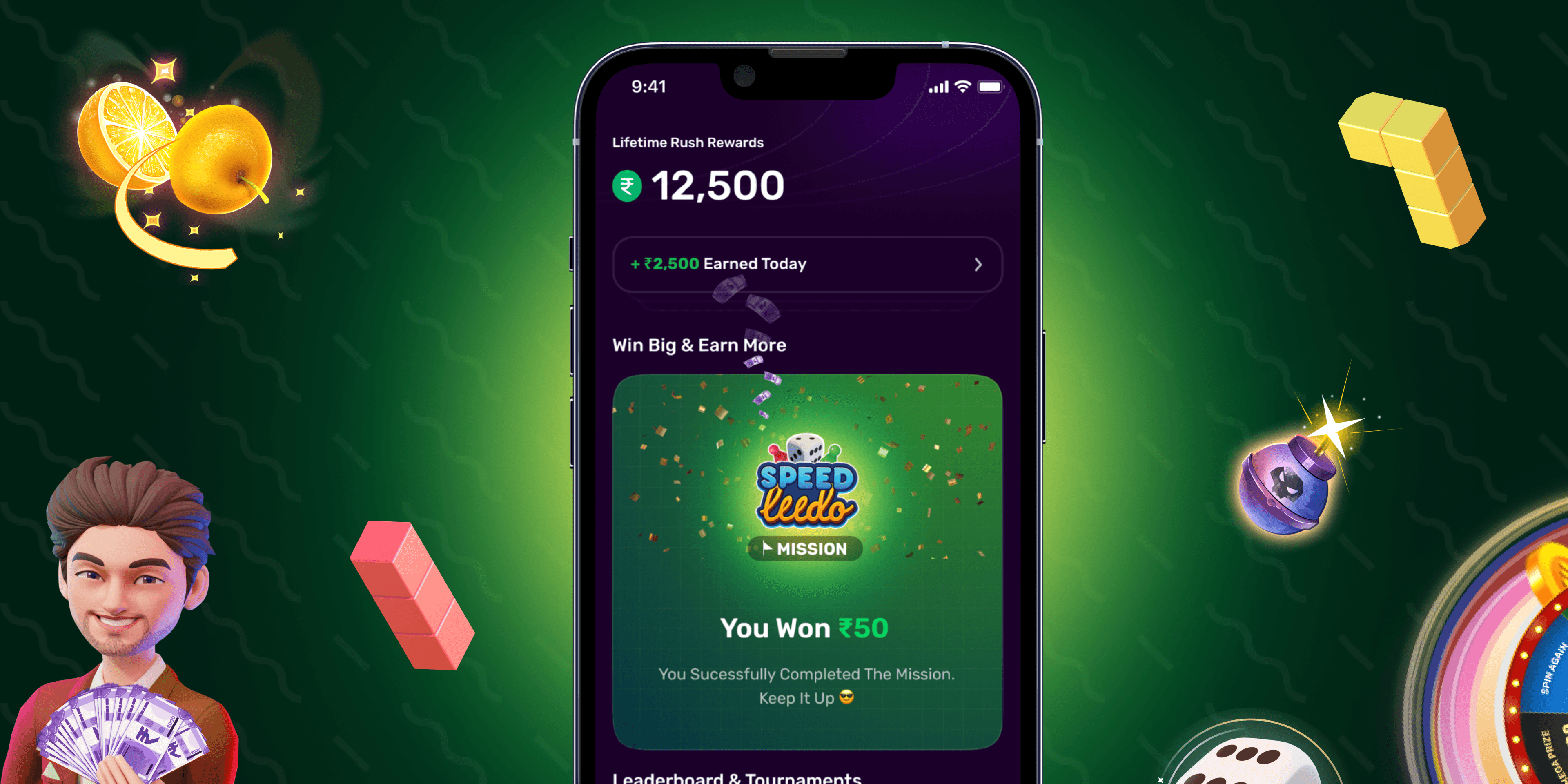



Game Missions : Boosting Revenue & Gameplays
Game Missions : Boosting Revenue & Gameplays
Game Missions : Boosting Revenue & Gameplays
Game Missions : Boosting Revenue & Gameplays
Discover how game missions and strategic gamification mechanics transformed revenues and gameplay at Rush. By leveraging enticing offers and tailored missions, we pushed users beyond their usual thresholds, unlocking higher rewards and increasing engagement. Learn how gamification mechanics can drive user engagement and fuel business growth in this case study.
Discover how game missions and strategic gamification mechanics transformed revenues and gameplay at Rush. By leveraging enticing offers and tailored missions, we pushed users beyond their usual thresholds, unlocking higher rewards and increasing engagement. Learn how gamification mechanics can drive user engagement and fuel business growth in this case study.
Discover how game missions and strategic gamification mechanics transformed revenues and gameplay at Rush. By leveraging enticing offers and tailored missions, we pushed users beyond their usual thresholds, unlocking higher rewards and increasing engagement. Learn how gamification mechanics can drive user engagement and fuel business growth in this case study.
Discover how game missions and strategic gamification mechanics transformed revenues and gameplay at Rush. By leveraging enticing offers and tailored missions, we pushed users beyond their usual thresholds, unlocking higher rewards and increasing engagement. Learn how gamification mechanics can drive user engagement and fuel business growth in this case study.
Problem Statement
Strategic & user centric implementation of Missions in app to improve revenue & gameplays.
Strategic & user centric implementation of Missions in app to improve revenue & gameplays.
Strategic & user centric implementation of Missions in app to improve revenue & gameplays.
Discovery
From push notifications to revenue tactic



In the pursuit of optimising user engagement and revenue generation, our business team conducted experiments with enticing offers for 1 week, such as "play 3 games and get Rs 5 bonus." Remarkably, this push notification campaign yielded a ~200% return on investment (ROI). Recognising the immense potential of this success, we seized the opportunity to leverage game social mechanics and introduce gameplay missions within our app.
In the pursuit of optimising user engagement and revenue generation, our business team conducted experiments with enticing offers for 1 week, such as "play 3 games and get Rs 5 bonus." Remarkably, this push notification campaign yielded a ~200% return on investment (ROI). Recognising the immense potential of this success, we seized the opportunity to leverage game social mechanics and introduce gameplay missions within our app.
In the pursuit of optimising user engagement and revenue generation, our business team conducted experiments with enticing offers for 1 week, such as "play 3 games and get Rs 5 bonus." Remarkably, this push notification campaign yielded a ~200% return on investment (ROI). Recognising the immense potential of this success, we seized the opportunity to leverage game social mechanics and introduce gameplay missions within our app.
What principles make a good gamification mechanic?
Clear Objectives: Define clear objectives for incorporating game social mechanics, ensuring they align with the overall goals of the game and enhance the player experience.
Meaningful Rewards: Provide meaningful and valuable rewards that motivate players to engage with the game and accomplish specific tasks or missions. Rewards should be desirable, relevant, and proportionate to the effort required.
Progression and Challenges: Create a sense of progression and challenge by offering levels, achievements, or milestones for players to strive towards. Gradually increasing difficulty keeps players engaged and provides a sense of accomplishment.
Social Interaction: Foster social interaction by integrating features such as leaderboards, multiplayer modes, or social sharing. Encourage players to connect, compete, cooperate, and communicate with each other.
Clear Objectives: Define clear objectives for incorporating game social mechanics, ensuring they align with the overall goals of the game and enhance the player experience.
Meaningful Rewards: Provide meaningful and valuable rewards that motivate players to engage with the game and accomplish specific tasks or missions. Rewards should be desirable, relevant, and proportionate to the effort required.
Progression and Challenges: Create a sense of progression and challenge by offering levels, achievements, or milestones for players to strive towards. Gradually increasing difficulty keeps players engaged and provides a sense of accomplishment.
Social Interaction: Foster social interaction by integrating features such as leaderboards, multiplayer modes, or social sharing. Encourage players to connect, compete, cooperate, and communicate with each other.
Clear Objectives: Define clear objectives for incorporating game social mechanics, ensuring they align with the overall goals of the game and enhance the player experience.
Meaningful Rewards: Provide meaningful and valuable rewards that motivate players to engage with the game and accomplish specific tasks or missions. Rewards should be desirable, relevant, and proportionate to the effort required.
Progression and Challenges: Create a sense of progression and challenge by offering levels, achievements, or milestones for players to strive towards. Gradually increasing difficulty keeps players engaged and provides a sense of accomplishment.
Social Interaction: Foster social interaction by integrating features such as leaderboards, multiplayer modes, or social sharing. Encourage players to connect, compete, cooperate, and communicate with each other.
Missions Experience MVP
For MVP we just launched missions with Clear objective & meaningful rewards.
As this was the first time our users were going to experience any kind of missions, we wanted to introduce the simplest yet the most delicious slice for our users. We wanted the missions to be customised at user cohort level because not every user has same frequency of gameplays, we wanted a relative positive shift in number of gameplays for each player where they don’t feel the reward is too far away to get and just challenging enough that it feels fun.
For MVP we just launched missions with Clear objective & meaningful rewards.
As this was the first time our users were going to experience any kind of missions, we wanted to introduce the simplest yet the most delicious slice for our users. We wanted the missions to be customised at user cohort level because not every user has same frequency of gameplays, we wanted a relative positive shift in number of gameplays for each player where they don’t feel the reward is too far away to get and just challenging enough that it feels fun.
For MVP we just launched missions with Clear objective & meaningful rewards.
As this was the first time our users were going to experience any kind of missions, we wanted to introduce the simplest yet the most delicious slice for our users. We wanted the missions to be customised at user cohort level because not every user has same frequency of gameplays, we wanted a relative positive shift in number of gameplays for each player where they don’t feel the reward is too far away to get and just challenging enough that it feels fun.
How our Missions worked?
For initial days, our product team read the performance data of our games & launched a new mission which was personalised at user level by the cohort that user exist in. 85% of our users daily visited the earn tab, so we primarily placed a Huge Mission tile over there for in-app discovery . Once user started playing the game as per mission, their progress was shown on the same card & once mission was concluded, we showed delightful animation of extra earning getting credited to the user.
For initial days, our product team read the performance data of our games & launched a new mission which was personalised at user level by the cohort that user exist in. 85% of our users daily visited the earn tab, so we primarily placed a Huge Mission tile over there for in-app discovery . Once user started playing the game as per mission, their progress was shown on the same card & once mission was concluded, we showed delightful animation of extra earning getting credited to the user.
For initial days, our product team read the performance data of our games & launched a new mission which was personalised at user level by the cohort that user exist in. 85% of our users daily visited the earn tab, so we primarily placed a Huge Mission tile over there for in-app discovery . Once user started playing the game as per mission, their progress was shown on the same card & once mission was concluded, we showed delightful animation of extra earning getting credited to the user.
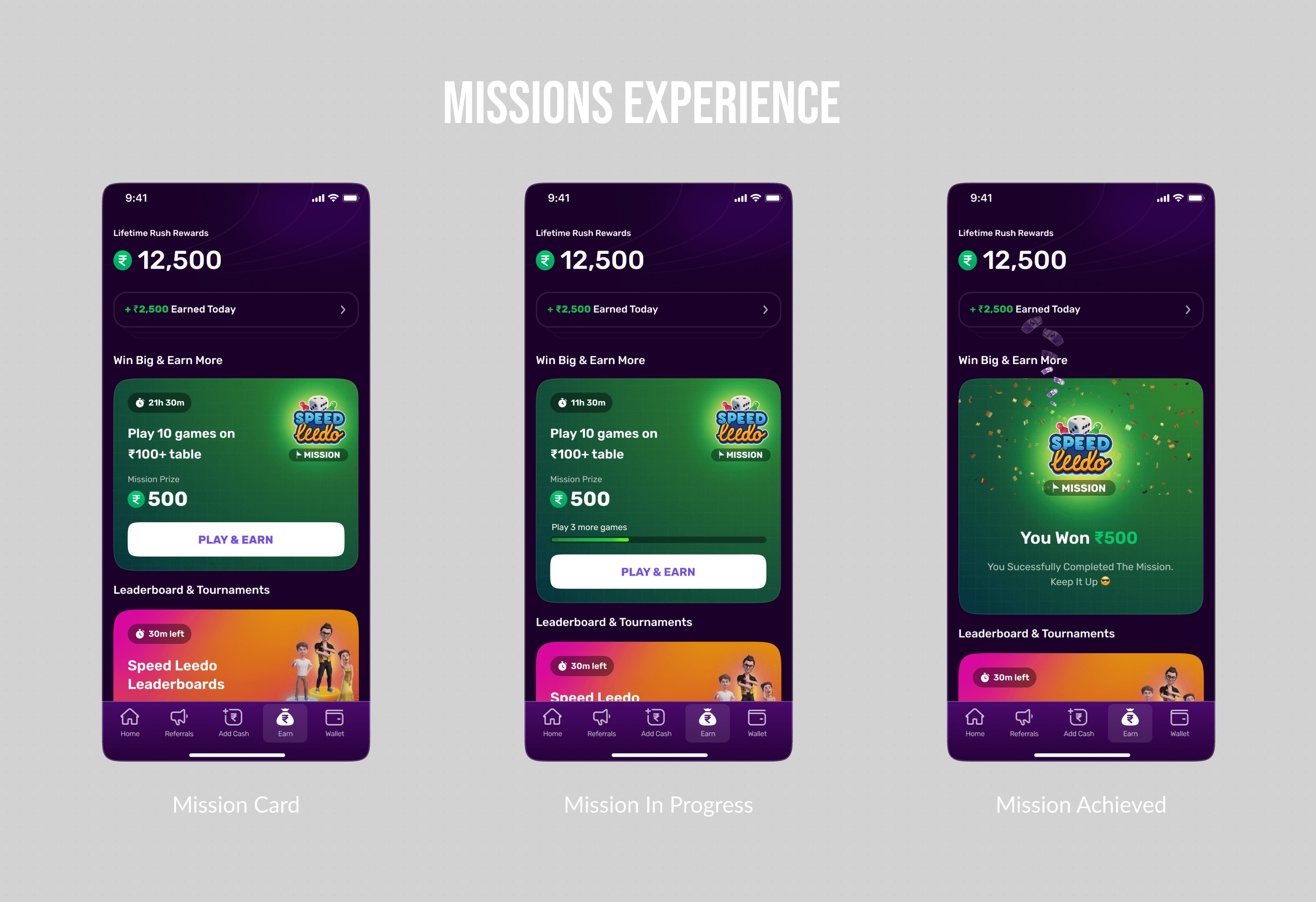


Results of MVP launch & Challenges
🟢 Revenue Boost : With ambitious missions, we reached around 600-700% ROI on missions launch in-app.
🟢 Gameplay boost : Relatively our gameplays increased by 10% in which users were playing on higher tables due to missions so per game ROI was high.
🔴 Poor Adoption : Even though the ROI of missions was 600-700%, the adoption rate was just 5%, +3% from the push notifications that business team did.
🔴 Poor Visibility : Although majority of users visited earn tab everyday but their frequency was just once-twice, while our missions expired in 12-24hrs, it was not a very optimal place way to keep users engaged with the missions.
🟢 Revenue Boost : With ambitious missions, we reached around 600-700% ROI on missions launch in-app.
🟢 Gameplay boost : Relatively our gameplays increased by 10% in which users were playing on higher tables due to missions so per game ROI was high.
🔴 Poor Adoption : Even though the ROI of missions was 600-700%, the adoption rate was just 5%, +3% from the push notifications that business team did.
🔴 Poor Visibility : Although majority of users visited earn tab everyday but their frequency was just once-twice, while our missions expired in 12-24hrs, it was not a very optimal place way to keep users engaged with the missions.
🟢 Revenue Boost : With ambitious missions, we reached around 600-700% ROI on missions launch in-app.
🟢 Gameplay boost : Relatively our gameplays increased by 10% in which users were playing on higher tables due to missions so per game ROI was high.
🔴 Poor Adoption : Even though the ROI of missions was 600-700%, the adoption rate was just 5%, +3% from the push notifications that business team did.
🔴 Poor Visibility : Although majority of users visited earn tab everyday but their frequency was just once-twice, while our missions expired in 12-24hrs, it was not a very optimal place way to keep users engaged with the missions.
RESolving The Challenges
We clearly realised that missions had huge revenue potential & dived deep into 2 critical tactics
Visibility : Increasing footprints of missions & placing them at relevant places in the app
Adoption : Deeper dive on the difficulty of missions, frequency & timing of push notifications
We clearly realised that missions had huge revenue potential & dived deep into 2 critical tactics
Visibility : Increasing footprints of missions & placing them at relevant places in the app
Adoption : Deeper dive on the difficulty of missions, frequency & timing of push notifications
We clearly realised that missions had huge revenue potential & dived deep into 2 critical tactics
Visibility : Increasing footprints of missions & placing them at relevant places in the app
Adoption : Deeper dive on the difficulty of missions, frequency & timing of push notifications
Increasing footprints in app (Visibility)
We identified the most visited and impactful places on our app where we could show user the progress of their missions.
Increasing footprints in app (Visibility)
We identified the most visited and impactful places on our app where we could show user the progress of their missions.
Increasing footprints in app (Visibility)
We identified the most visited and impactful places on our app where we could show user the progress of their missions.
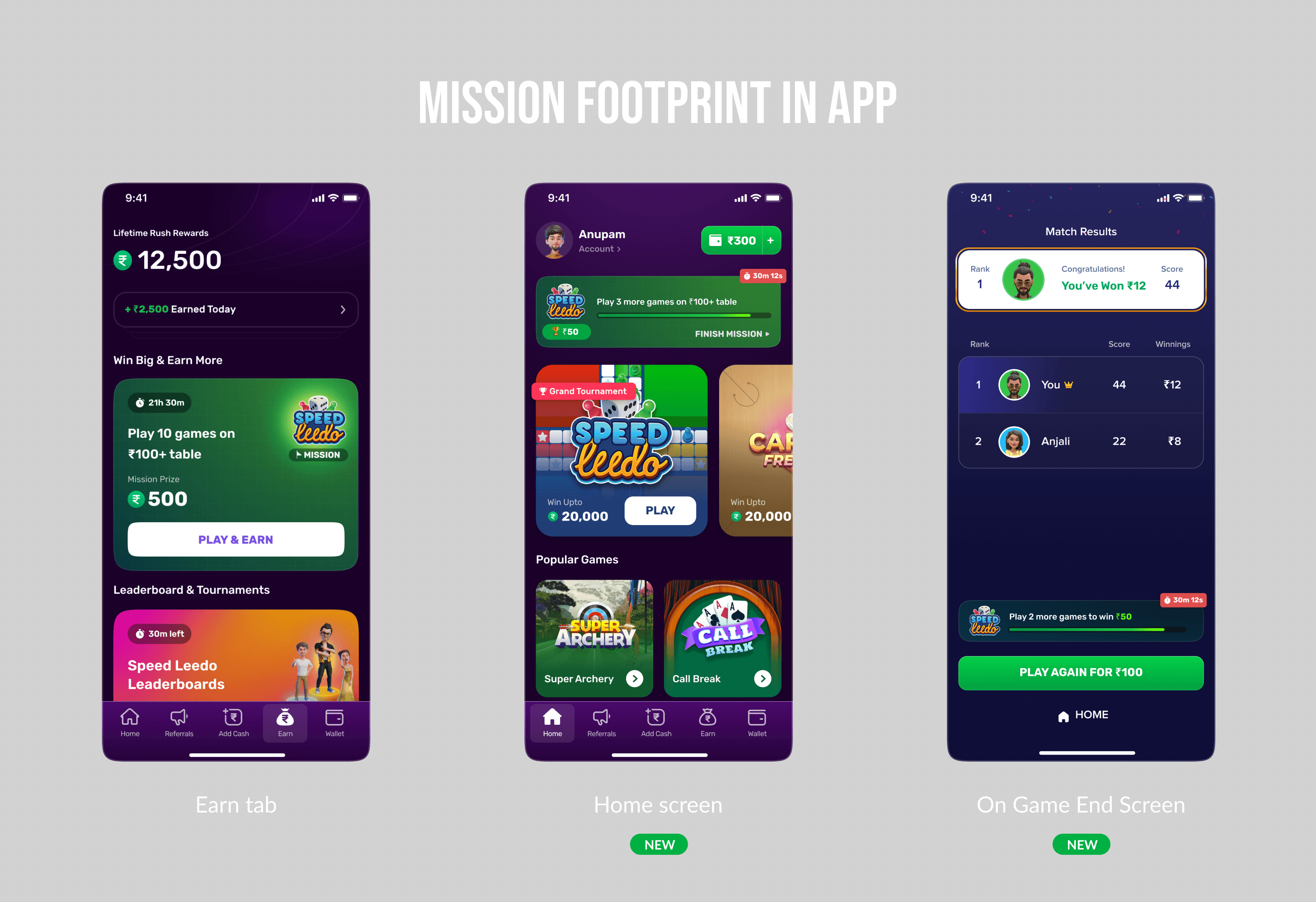


Deeper dive to solve for Adoption
We realised that notifications were sent randomly throughout the day to the users. Hence we immediately corrected it, & we adopted a systematic approach by sending notifications in two key timeframes:
🟢 Morning: Notifying users about new missions for the day.
🟢 Evening: Sent around 7pm to inform users that they risk missing out on the mission or their progress may go to waste, based on data showing high user activity during late-night gameplay.
Missions were overly challenging, Previous missions asked too much from users, resulting in low completion rates (30%).
🟢 Revised approach: Reduced mission complexity to strike a balance between revenue generation and user motivation.
🟢 The aim was to keep the tactic effective in generating revenue while keeping users engaged and motivated to achieve the mission targets and obtain the reward amount.
We realised that notifications were sent randomly throughout the day to the users. Hence we immediately corrected it, & we adopted a systematic approach by sending notifications in two key timeframes:
🟢 Morning: Notifying users about new missions for the day.
🟢 Evening: Sent around 7pm to inform users that they risk missing out on the mission or their progress may go to waste, based on data showing high user activity during late-night gameplay.
Missions were overly challenging, Previous missions asked too much from users, resulting in low completion rates (30%).
🟢 Revised approach: Reduced mission complexity to strike a balance between revenue generation and user motivation.
🟢 The aim was to keep the tactic effective in generating revenue while keeping users engaged and motivated to achieve the mission targets and obtain the reward amount.
We realised that notifications were sent randomly throughout the day to the users. Hence we immediately corrected it, & we adopted a systematic approach by sending notifications in two key timeframes:
🟢 Morning: Notifying users about new missions for the day.
🟢 Evening: Sent around 7pm to inform users that they risk missing out on the mission or their progress may go to waste, based on data showing high user activity during late-night gameplay.
Missions were overly challenging, Previous missions asked too much from users, resulting in low completion rates (30%).
🟢 Revised approach: Reduced mission complexity to strike a balance between revenue generation and user motivation.
🟢 The aim was to keep the tactic effective in generating revenue while keeping users engaged and motivated to achieve the mission targets and obtain the reward amount.
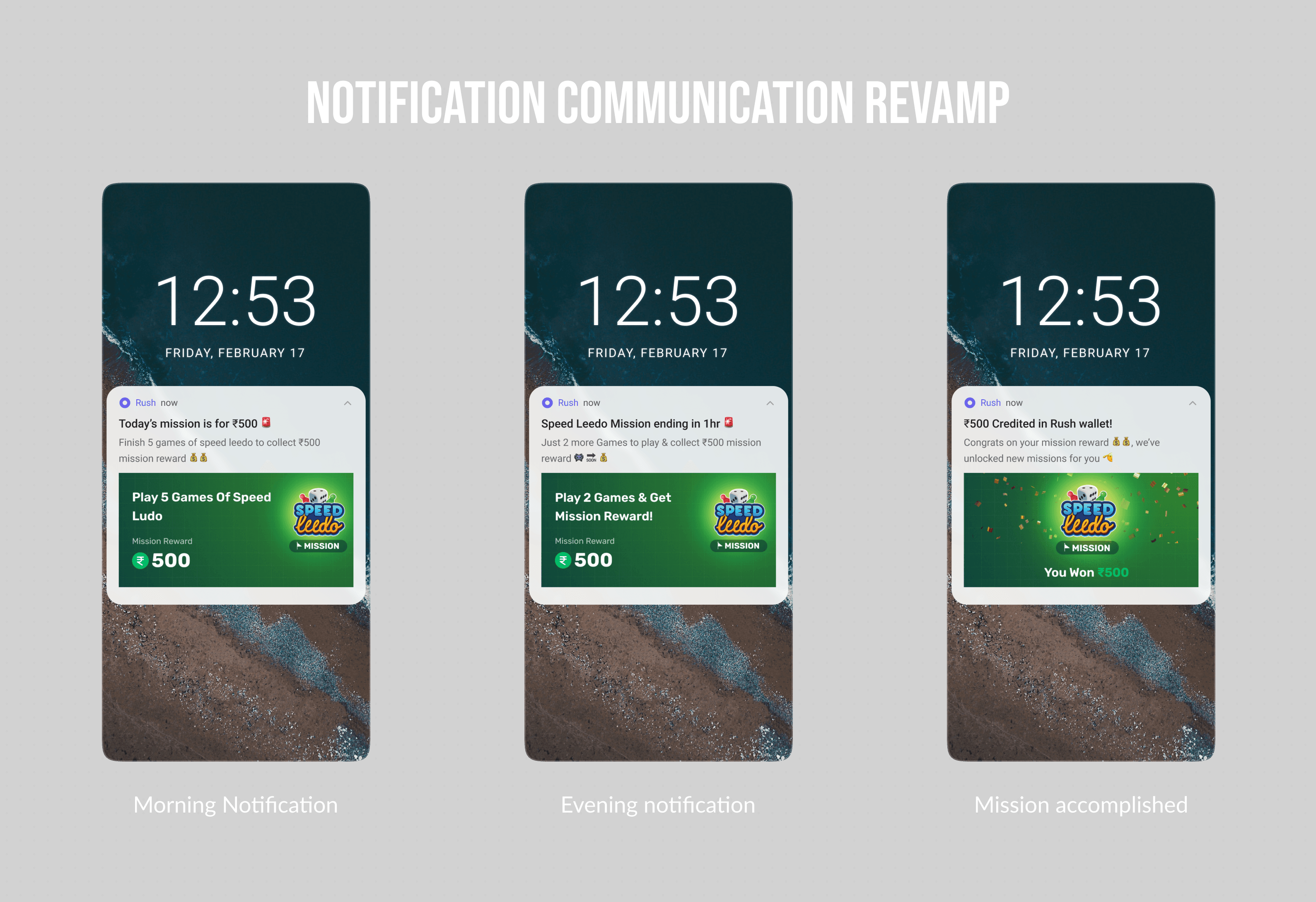


Key Results with new tactics
Test flow showcased a significant +10% improvement in overall adoption of missions.
Revamped mission strategies and implementation led to 30% higher gameplay.
Insights gained from the test flow helped define clear guidelines for future mission launches.
User-centric design, mission relevance, and appropriate complexity levels were identified as key factors for success.
Test flow showcased a significant +10% improvement in overall adoption of missions.
Revamped mission strategies and implementation led to 30% higher gameplay.
Insights gained from the test flow helped define clear guidelines for future mission launches.
User-centric design, mission relevance, and appropriate complexity levels were identified as key factors for success.
Test flow showcased a significant +10% improvement in overall adoption of missions.
Revamped mission strategies and implementation led to 30% higher gameplay.
Insights gained from the test flow helped define clear guidelines for future mission launches.
User-centric design, mission relevance, and appropriate complexity levels were identified as key factors for success.
Reflection
Although we made a significant stride of overall 15% improvement in overall adoption of missions at 300-400% ROI, there was still so much more to achieve, it has become one of the prime tactics in Rush to boost revenue numbers. Our users were mostly rewarded with real cash as reward which could only be increased to certain extent and started appearing as a bottle neck to the system in improving adoption. Which is the Next mission to solve 😎
THANKS FOR THE READ ✨
THANKS FOR THE READ ✨
THANKS FOR THE READ ✨
THANKS FOR THE READ ✨




